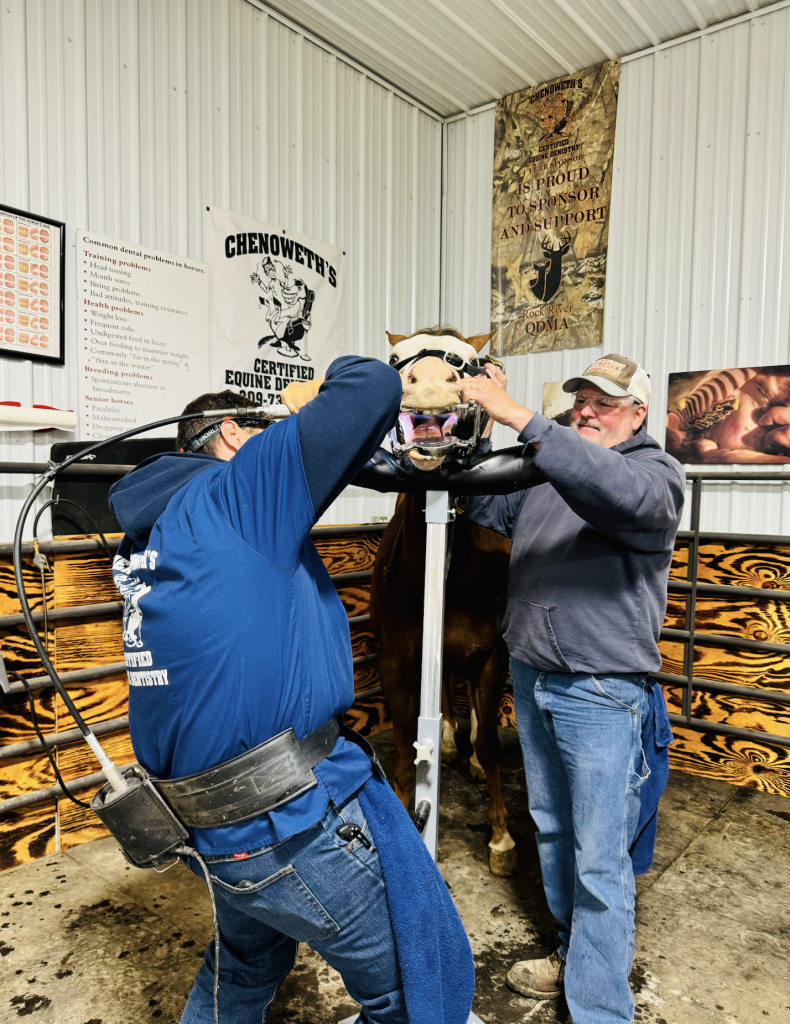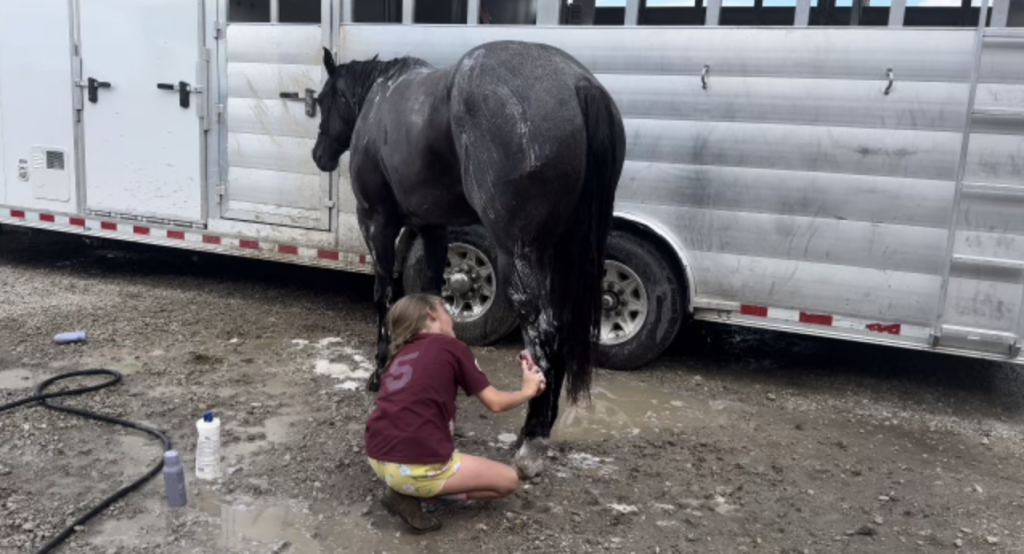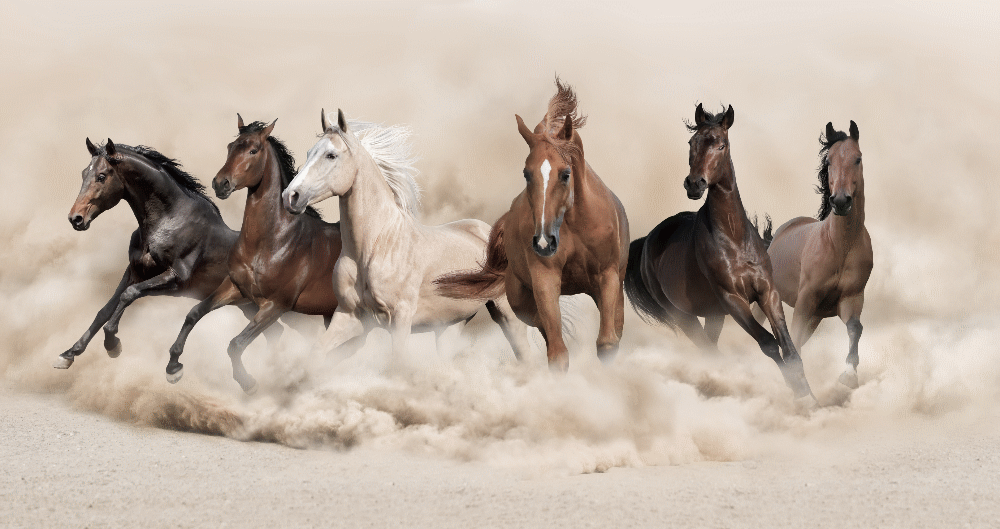
Preparing a horse for sale requires careful planning and attention to detail across nutrition, conditioning, grooming, and training. By following best practices in these areas, you can maximize your horse’s appeal and value to potential buyers in today’s competitive equine market.
Key takeaways: 1. Proper nutrition and conditioning are essential for achieving optimal body condition and fitness. 2. Thorough grooming and presentation make a strong first impression on potential buyers. 3. Basic training and good ground manners significantly increase a horse’s marketability. 4. High-quality photos and videos are crucial for effective online marketing. 5. Providing comprehensive health records and after-sale support builds buyer confidence.
Introduction
Here at Rocking L Equine, we know that preparing a horse for sale is both an art and a science. The equine industry is a hidden giant, with an annual economic impact of $300 billion worldwide1. In the United States alone, the horse population stands at an impressive 7.2 million, owned or leased by over 1 million individuals2. These figures underscore the immense potential and responsibility that comes with readying horses for the market.
Proper preparation is paramount when selling horses, as it can significantly impact the animal’s value and appeal to potential buyers. A well-prepared horse not only looks its best but also demonstrates optimal health, behavior, and performance capabilities. This comprehensive approach encompasses various aspects, from physical conditioning to behavioral training and presentation skills.
In this guide, we’ll walk you through the key steps to prepare your horse for sale, drawing on our years of experience in the equine industry. Whether you’re selling a seasoned performance horse or a promising young prospect, these tips will help you showcase your horse’s best qualities and find the right match with a new owner.
Assessing Your Horse’s Condition

Health Check: Veterinary Assessment, Vaccinations, and Deworming
A comprehensive health check is the foundation of preparing your horse for sale. This evaluation typically includes a thorough veterinary assessment, up-to-date vaccinations, and an effective deworming program. At Rocking L Equine, we recommend starting with a detailed physical examination by a qualified equine veterinarian.
During the veterinary assessment, your horse’s vital signs, body condition, and major body systems will be evaluated. This may involve listening to the heart, lungs, and gut sounds, as well as checking the eyes, ears, nose, and mouth for any abnormalities. The veterinarian will also palpate your horse’s muscles, bones, joints, tendons, and ligaments to identify any areas of concern3.
Ensuring your horse’s vaccinations are current is crucial. The American Association of Equine Practitioners (AAEP) recommends core vaccinations for all horses, which include protection against rabies, tetanus, West Nile virus, and Eastern and Western equine encephalomyelitis4. Depending on your horse’s location and intended use, additional risk-based vaccinations may be recommended.
Deworming is another critical component of the health check process. We recommend a targeted approach based on fecal egg counts and individual horse factors, rather than adhering to a rigid rotational deworming schedule5. This method helps prevent anthelmintic resistance while ensuring your horse remains parasite-free.
Nutrition: Optimal Diet and Supplements for Improving Condition
Proper nutrition plays a vital role in preparing horses for sale, as it directly influences their overall appearance and health. At Rocking L Equine, we emphasize the importance of a well-designed feeding program that provides adequate energy for exercise, supports muscle development, and promotes a healthy hair coat.
For young horses, such as yearlings, we recommend feeds containing 14-17% protein to support proper growth and muscle development6. Super fibers like beet pulp and soybean hulls can be beneficial for adding healthy calories without the risks associated with high-starch diets7.
Incorporating healthy fats, such as flaxseed oil, can enhance coat condition and increase energy intake. For coat improvement, we typically suggest a minimum of 60g per day of vegetable oil or about 250g of stabilized rice bran[^6].
Regular body condition assessments are crucial to ensure your horse maintains an ideal weight throughout the preparation process. We aim for a body condition score of 5, where ribs cannot be seen but can be easily felt[^7].
Fitness: Exercise Regimen to Build Stamina and Muscle Tone
A well-structured fitness plan is essential for building stamina and muscle tone in horses being prepped for sale. At Rocking L Equine, we tailor our exercise programs to each horse’s age, current fitness level, and intended discipline.
For young horses, we often start with long, slow distance (LSD) work to improve endurance and oxygen uptake. This can include a combination of hacking, arena work, lunging, and use of a horse walker. As fitness improves, we gradually increase the duration and intensity of workouts[^8].
For more advanced horses, we incorporate interval training to challenge the cardiovascular system and improve overall fitness. This method involves alternating periods of higher-intensity exercise with slower recovery periods[^8].
Hill work is another effective tool in our fitness arsenal. Walking and trotting up hills encourages horses to engage their hindquarters and abdominal muscles, promoting the development of a strong topline[^9].
Throughout the conditioning process, we closely monitor each horse’s progress, adjusting the program as needed to ensure optimal results without risking overtraining or injury.
Grooming and Presentation

Daily Grooming: Brushing, Bathing, and Hoof Care
At Rocking L Equine, we believe that daily grooming is essential for keeping your horse looking its best and maintaining optimal health. Our grooming routine includes thorough brushing, regular bathing, and meticulous hoof care.
We start each grooming session with a curry comb to loosen dirt and dead hair, followed by a dandy brush to remove debris. We finish with a soft body brush to bring out the natural oils and create a polished appearance[^10].
While we don’t bathe horses daily, we perform thorough washes every few weeks using equine-specific shampoos. Special attention is paid to white markings, using whitening shampoos when necessary. We always follow up with a conditioner for the mane and tail to keep them soft and manageable[^11].
Hoof care is a critical component of our daily grooming routine. We clean hooves daily using a hoof pick to remove dirt, debris, and stones that can cause discomfort or lead to infections. This also provides an opportunity to inspect the frog, sole, and walls of the hoof for any signs of injury or disease[^12].
Mane and Tail: Trimming and Braiding for a Polished Look
Proper mane and tail care significantly enhances a horse’s overall appearance and appeal to potential buyers. At Rocking L Equine, we tailor our approach to each horse’s breed standard and intended discipline.
For hunter/jumper, dressage, and eventing horses, we typically maintain a shorter, pulled mane of about 4-6 inches. We use a pulling comb to thin the mane evenly, working our way up the neck[^13].
When trimming tails, we focus on creating a neat, full appearance that enhances the horse’s overall silhouette. We start by detangling the tail using our fingers or a wide-toothed comb, working from the bottom up to avoid breakage. We then trim any straggly ends by holding the tail straight down and cutting across at an angle, creating a neat point[^13].
For sale presentations, we often incorporate more elaborate braiding styles to make our horses stand out. The specific technique depends on the horse’s breed and intended use, ranging from traditional button braids for hunter/jumpers to loose, romantic braids for breeds with longer manes[^14].
Final Touches: Clipping, Polishing Hooves, and Other Finishing Details
In the weeks leading up to a sale, we focus on fine-tuning each horse’s appearance with careful attention to detail. This includes clipping, hoof polishing, and other finishing touches that can make a significant difference in presentation.
We typically begin clipping 2-3 weeks before the sale, allowing time for any touch-ups. The specific clipping pattern depends on the horse’s coat color, breed, and intended discipline. For light-colored or pink-skinned horses, we use a medium-grade blade to achieve a more natural finish[^15].
Hoof polishing is another crucial final touch. We start by thoroughly cleaning the hooves with a Brillo pad, then apply a high-quality hoof dressing for black hooves or mineral oil for white hooves to achieve a polished look[^16].
For any white markings, we often apply baby powder to brighten and accentuate these areas. In cases where there are small blemishes or missing hair on white markings, we use a thin layer of diaper rash cream followed by baby powder to create a more flawless appearance[^16].
These finishing touches, combined with our comprehensive preparation process, help ensure that each horse looks its absolute best when presented to potential buyers.
Training and Behavior
Basic Training: Ensuring the Horse Responds to Basic Commands
At Rocking L Equine, we believe that a well-mannered horse with solid basic training is far more appealing to potential buyers. Our training approach focuses on clear, consistent communication between handler and horse, utilizing both verbal and non-verbal cues to elicit desired responses.
We employ positive reinforcement techniques to teach and reinforce basic commands. For instance, when teaching the “whoa” command, we pair the verbal cue with a physical stop, immediately rewarding the horse when they comply. This creates a positive association with the command and encourages future responsiveness[^17].
Consistency is key in our training process. We use the same words, tones, and physical cues each time we ask for a specific action. This repetition helps horses understand what is expected and builds their confidence in responding correctly[^18].
As part of our sale preparation, we ensure that each horse is proficient in the following basic commands:
- Walk on
- Whoa (stop)
- Back up
- Stand
- Turn (left and right)
We also focus on teaching horses to respond to subtle physical cues, as many equestrian disciplines discourage excessive vocalization during competition[^19].
Desensitization: Familiarizing the Horse with Various Stimuli
Preparing a horse for sale involves more than just physical conditioning and basic training. At Rocking L Equine, we place great emphasis on desensitization to ensure our horses are adaptable and less reactive to various stimuli they may encounter in new environments.
We employ a systematic desensitization approach, gradually introducing potentially frightening stimuli while keeping the horse below its fear threshold. This method allows the horse to build confidence and learn that new objects or situations are not threats[^20].
Our desensitization program typically includes exposure to:
- Unusual objects (umbrellas, tarps, balloons)
- Loud or sudden noises
- Machinery and vehicles
- Crowds and unfamiliar people
- Various types of footing and terrain
We often combine desensitization with counter-conditioning, pairing potentially scary stimuli with positive experiences like treats or praise. This creates a positive association and helps the horse view new situations as opportunities rather than threats[^21].
Ground Manners: Polite Behavior When Handled from the Ground
Good ground manners are essential for horses being prepared for sale, as they demonstrate the animal’s trainability, temperament, and overall handling ease to potential buyers. At Rocking L Equine, we focus on teaching horses to respect personal space and respond appropriately to body language and verbal cues.
Our ground manners training includes:
- Standing quietly for grooming and tacking up
- Leading politely at walk and trot
- Backing up on command
- Standing still for mounting
- Respecting personal space
- Picking up feet willingly for cleaning and farrier work
We achieve these behaviors through consistent handling and positive reinforcement. When a horse invades personal space, for example, we immediately ask them to move away, making it uncomfortable to be too close. This teaches the horse to maintain a respectful distance[^22].
By focusing on these aspects of training and behavior, we ensure that our horses are not only physically prepared for sale but also well-mannered and easy to handle, increasing their appeal to potential buyers.
References
- Equine Business Association. (2023). Equine Industry Statistics. ↩
- American Horse Council. (2023). US Horse Population Statistics. ↩
- Cornell University College of Veterinary Medicine. (2023). Equine Pre-Purchase Exams: What to Expect. ↩
- American Association of Equine Practitioners. (2023). Adult Horse Vaccination Chart. ↩
- Colorado State University Veterinary Teaching Hospital. (2023). Equine Recommended Deworming Schedule. ↩
- Kentucky Equine Research. (2023). Feeding Yearlings for Sales Preparation. ↩
- Platinum Performance. (2023). Let Health Shine. ↩
